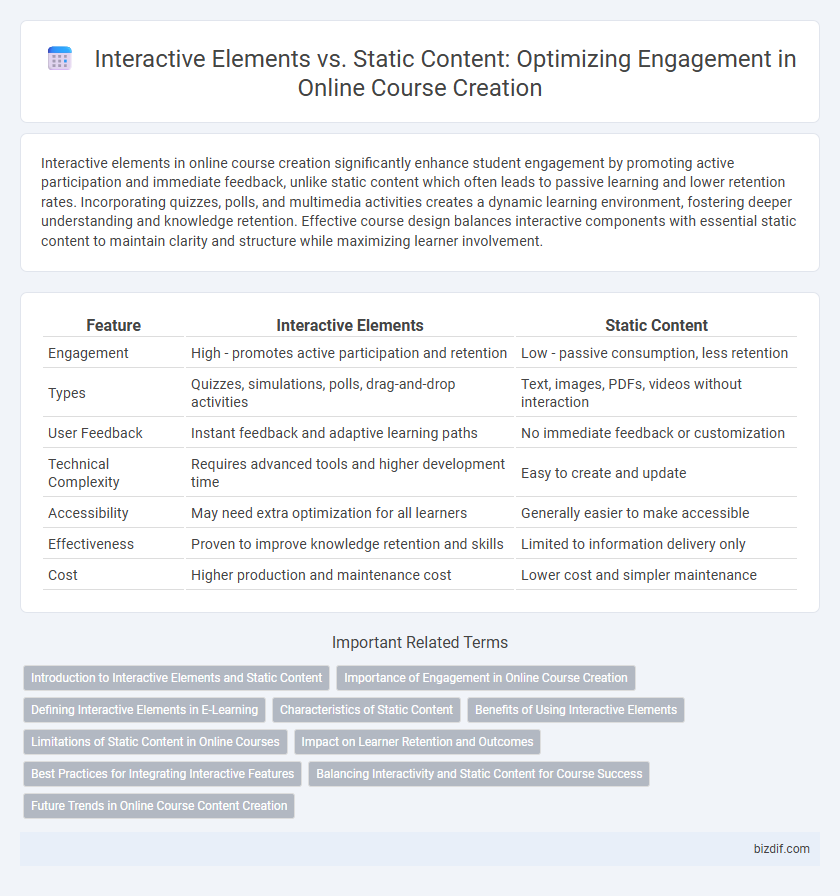Interactive elements in online course creation significantly enhance student engagement by promoting active participation and immediate feedback, unlike static content which often leads to passive learning and lower retention rates. Incorporating quizzes, polls, and multimedia activities creates a dynamic learning environment, fostering deeper understanding and knowledge retention. Effective course design balances interactive components with essential static content to maintain clarity and structure while maximizing learner involvement.
Table of Comparison
| Feature | Interactive Elements | Static Content |
|---|---|---|
| Engagement | High - promotes active participation and retention | Low - passive consumption, less retention |
| Types | Quizzes, simulations, polls, drag-and-drop activities | Text, images, PDFs, videos without interaction |
| User Feedback | Instant feedback and adaptive learning paths | No immediate feedback or customization |
| Technical Complexity | Requires advanced tools and higher development time | Easy to create and update |
| Accessibility | May need extra optimization for all learners | Generally easier to make accessible |
| Effectiveness | Proven to improve knowledge retention and skills | Limited to information delivery only |
| Cost | Higher production and maintenance cost | Lower cost and simpler maintenance |
Introduction to Interactive Elements and Static Content
Interactive elements in online course creation engage learners through quizzes, polls, and multimedia, enhancing retention and participation. Static content includes text, images, and videos that provide foundational knowledge but lack real-time learner interaction. Combining both types optimizes educational effectiveness by balancing information delivery with active learner involvement.
Importance of Engagement in Online Course Creation
Interactive elements such as quizzes, polls, and discussion forums significantly enhance learner engagement by fostering active participation, whereas static content often leads to passive consumption and reduced retention. Research shows courses incorporating interactive features increase completion rates by up to 50%, emphasizing their critical role in maintaining student motivation. Prioritizing engagement through dynamic content design ensures deeper understanding and improved learning outcomes in online course creation.
Defining Interactive Elements in E-Learning
Interactive elements in e-learning are dynamic components such as quizzes, simulations, drag-and-drop activities, and clickable diagrams that engage learners by requiring active participation. These elements enhance knowledge retention and critical thinking by providing immediate feedback and promoting hands-on experience. Unlike static content that only presents information passively, interactive elements foster deeper learning through user interaction and personalized responses.
Characteristics of Static Content
Static content in online course creation features fixed, unchanging materials such as PDFs, slides, and videos that offer consistent information delivery without user interaction. This type of content is easy to produce, highly accessible, and ideal for straightforward knowledge transfer but lacks engagement and real-time feedback opportunities. Static elements provide a stable foundation for learners who prefer self-paced study without interactive distractions.
Benefits of Using Interactive Elements
Interactive elements in online course creation significantly boost learner engagement by promoting active participation and immediate feedback, fostering better knowledge retention and skill development. These elements, such as quizzes, simulations, and drag-and-drop exercises, adapt to diverse learning styles, enhancing personalization and motivation. Unlike static content, interactive features encourage critical thinking and real-world application, leading to improved learner outcomes and course effectiveness.
Limitations of Static Content in Online Courses
Static content in online courses often limits learner engagement and interactivity, resulting in lower retention rates and diminished motivation. Without interactive elements such as quizzes, simulations, and discussion forums, students may struggle to apply knowledge in practical contexts or receive immediate feedback. This lack of dynamic engagement can hinder personalized learning experiences, making it challenging to address diverse learning styles and needs effectively.
Impact on Learner Retention and Outcomes
Interactive elements such as quizzes, simulations, and discussion forums significantly enhance learner retention by actively engaging users and promoting deeper cognitive processing compared to static content like text or video lectures. Studies show courses featuring interactive components result in higher completion rates and improved knowledge retention, leading to better learning outcomes. Incorporating dynamic activities encourages critical thinking and practical application, which are crucial for long-term skill acquisition.
Best Practices for Integrating Interactive Features
Incorporate quizzes, polls, and simulations to increase learner engagement and retention in online course creation. Utilize multimedia elements like videos and infographics to complement static content, ensuring diverse learning preferences are addressed. Optimize interactive features for mobile devices and provide clear instructions to enhance user experience and accessibility.
Balancing Interactivity and Static Content for Course Success
Balancing interactive elements with static content enhances learner engagement and knowledge retention by combining dynamic activities with clear, concise information. Interactive components like quizzes, simulations, and discussions encourage active participation, while static materials such as videos, readings, and slides provide foundational knowledge and easy reference. Effective online course design strategically integrates both to cater to diverse learning styles and maximize educational outcomes.
Future Trends in Online Course Content Creation
Future trends in online course content creation emphasize the integration of interactive elements such as quizzes, simulations, and gamified activities to enhance learner engagement and retention. Static content like PDFs and recorded lectures are increasingly supplemented or replaced by dynamic, adaptive learning experiences driven by AI and real-time analytics. These advancements promote personalized learning paths and foster deeper comprehension, setting a new standard for effective e-learning environments.
Interactive Elements vs Static Content Infographic

 bizdif.com
bizdif.com